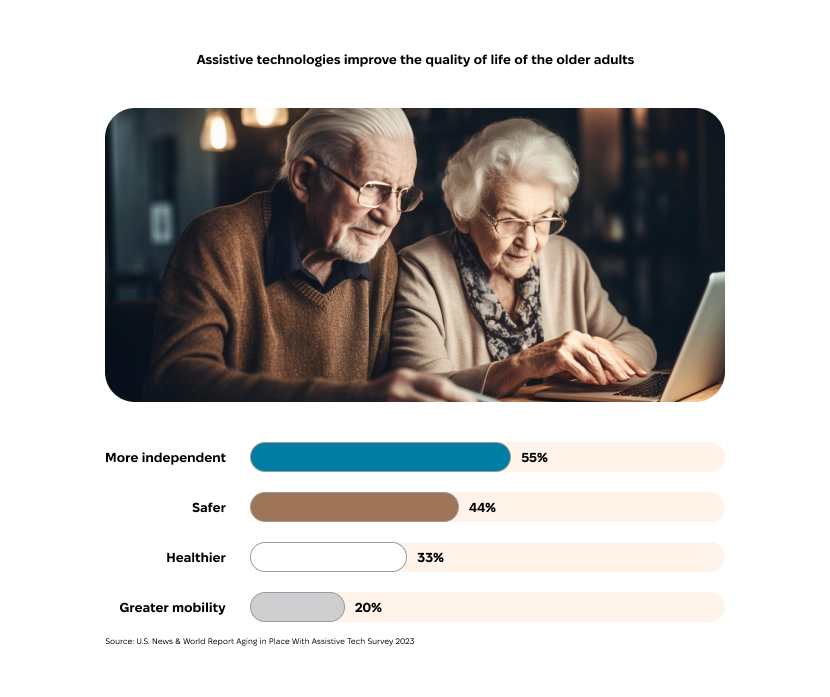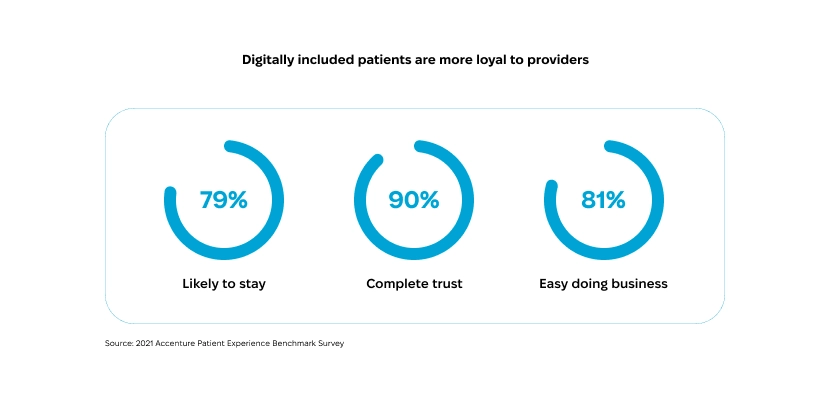«By 2030, one in six people globally will be aged 60 years or older, according to the WHO (World Health Organization)»
As life expectancy increases, a bigger number of older adults will need a helping hand. Still, senior care facilities and hospitals aren't fully prepared, facing staffing shortages, access issues, and longer treatment times. Technology helps address the daily problems of older adults, expand their treatment options, improve their patient experience, and make care more affordable. Read our blog post to learn more.
The Age of the Aged Care Technology
Good news! On average, people worldwide are enjoying longer lives, with the majority expected to reach their sixties and beyond.
Longer life spans bring in opportunities not just for older adults and their families but
also for society in general: from new interests exploration and refining the career paths
to more quality living/family time and contribution to communities. However, there is a
key factor directly affecting the opportunities of every individual but specifically
elderly people - it’s the age-related health.
However, these opportunities are not without concerns. For example, governments all over the
world are facing challenges to adapt socio-health systems to the demographic shift. As the
aged care is a growing topic both in politics and in the market, the question “Where does it
hurt?” is now applied outside of the original context.

Why Ring the Alarm?
In the 21st century, it is essential to rethink how we approach healthcare in general and
senior care as a significant part of it. It does look like instead of asking conventional
questions, we should focus on “How we can support you in living your life well?” making it
possible for older persons to live their lives to the fullest as well as to have a healthy
aging.
That’s where the reality strikes with some painful challenges facing the aged care sector:
Staffing Crisis in Senior Care
A shortage of skilled resources within the workforce is a critical issue in many
industries, but a global caregiver labour gap is turning into a drastic problem. Funding
shortfalls, pandemic-induced downsizing, poor training and career progression
opportunities, low wages for such physically and mentally demanding work impede the
chances of aged care sector to recruit and sustain healthcare professionals.
Healthcare human resource ecosystem can benefit from external assistance, stemming from governments, private investors, senior care technology,
technology modernization services, as well as other healthtech stakeholders.
Efficiency and (or?) Equity for Elderly
One of the issues recently highlighted is that participants in healthcare industry systems
often experience obstacles to medical services. The aged care system’s affordability,
diversity, and access, linked with social, economic, or environmental factors negatively
influence outcomes, especially for older adults.
Eliminating health disparities and achieving health equity is a complex task requiring meticulous
strategy and profound financial, technological and social support.
Time-to-Outcomes Healthcare for Older Adults
It’s no secret that time in healthcare is a sensitive topic combined with high treatment
costs, workforce shortage, and the complex needs of the elderly. All these reasons call
for changing the care model to serve older adults while removing the financial burden from
the society.
Promoting and maintaining acuity levels in society on the whole and in older persons in particular
can improve their quality of life, independence and overall well-being. Needless to say that
these models require sustainable effort and investment.
So Where Are We Now With Aged Care Technologies?
Healthcare industry of today is cautiously allowing technology innovation into its
ecosystem. As a consequence, digital health begins to influence the everyday life of the
patients and providers. The medical sector is prone to change and development as it sits
upon a ‘klondike’ of data, propped up by tools and innovative tech platforms, driven by a
connected informed patient as well as economic influences.
Technology for elderly care is already addressing some of the everyday needs, be it long-term
senior care technology or changing health concerns. The AAL (active assisted living) solutions
range from health-related or medical mobile apps to
telemedicine software apps and wearables to virtual assistants, remote patient monitoring
devices, medical alert systems, intelligent home monitoring systems, to actual robotics applications.
The health tech turns into a care assistant for older adults enabling health status self-monitoring,
promoting healthy lifestyle habits, physical independence and social interaction, facilitating
early diagnosis, and assuring further adequate treatment.
«53% of U.S. adults aged 55 and older use assistive or health-related technology»
Actualizing Better Health And Elder Care
According to AARP’s latest “Tech Trends and the 50-Plus” study, technology adoption among older adults that was originally pandemic-driven is now commonly used. They are watching technology development and growing familiar with it. The main trend of social interaction in 2021 was the older persons’ use of tech in order to stay connected in addition to using their devices to be entertained and manage day-to-day living.

Now some sour news. As much as we want to believe in new and shiny
machine-powered tech to come and save humanity, the real goal for any medicare system is
to improve the value delivered to patients while carefully managing (aka cutting)
expenditures. Since healthcare is competing hard for governments’ decisions and investors'
attention in crowded and constantly changing markets, it desperately needs help and
guidance to stay ahead.
Technology is a proven instrument doing its job as it is designed to do: bolster the aged care
sector into becoming a consolidated, interoperable, standardized network as a part of the bigger
medicare ecosystem.
We have long since heard about “digital transformation” of healthcare or “intelligent” everything
in care services. But, all the hype is coming down to the same universal concept: understanding
the value of healthcare.
Healthcare value depends on the ratio of patient outcomes achieved to costs spent. Those measured
outcomes and costs include the entire care cycle - from initial contact with the medical system
through diagnostics to treatment and ongoing management. In reality - especially with chronic
and interrelated conditions - there are more services which contribute to associated costs,
but not necessarily yield better care outcomes. That’s precisely where digital technology with
custom healthcare solutions steps in. With health spending projected to grow, the emerging
health ecosystem is only likely to mature with the help of digital, relying upon the set of
interconnected stakeholders participating in senior health, including public and private payers,
aged care facilities, providers and suppliers.
Health Delivery Turning into Comfort Aging
Humanizing technology to integrate health into aged care technology solutions, extended
lifespan and well-being has the potential to increase older individuals’ freedom of
choice, their ability to exercise their rights for a full life independence, keeping
connected, active, and support professional fulfillment. The collaboration of humans and
machines allow us to develop a multichannel health delivery system with the individual at
its core. Precision diagnoses, effective monitoring, tailored
health metrics management, personalized treatments based on smart sensors, LOCs (lab-on-a-chip), remote patient
monitoring devices, health data analysis, and AI algorithms are tangible benefits.
Entire new approaches to self-awareness that control activities, choices, and lifestyles leading
to a state of holistic health means fewer hospital visits as well as less financial pressure
on aged care facilities. The socio-economic benefits of such a leap come also with the improved
mental health of individuals, while providing timely care and medical interventions at reduced
costs.
Healthcare Platforms and APIs Bring a Digital Health Pass to Market
The aim of improving healthcare services capacity through technology is to prioritize
patient-consumer convenience and shift the focus towards preventive measures rather than
curative treatments, which leads to easing the burden on critical health systems (with
associated cost benefits).
Resident experience platforms for senior living
are a digitally connected network of public, private, community service providers, and
data sources that enable value chain integrations. By reaching different partnerships such
as clinic establishment, care providers (general practitioners, medical specialists,
geriatricians), wellness service providers (pharmacies, fitness services, dietary
management, and mental health) with data acquisition, financing and insurance, and other
assets related to health - service delivery directly influences services scale and scope.
At the technology level, Application Programming Interfaces (APIs) are the backbone of the
health sector transformation towards platforms enabling companies to efficiently build custom
solutions by making use of the existing technology from the
trusted provider. Strategic API
application puts the power to securely operate on healthcare data into the hands of the
healthcare consumer and allows communication between patients and clinicians, integrating
insurance workflows and providers in secure unified systems.
«Nearly 90% of healthcare stakeholders believe APIs are mission-critical to their business strategies.»
Why is it important? The concept of a collaborative or participative
economy is transforming the consumer relationship across various industries. This change
involves integrating care, liberating data, and acting on information, benefiting all
participants in the ecosystem. Companies are responding by offering connected tools and
empowering patients and consumers with information to make personalized healthier choices.
An API-powered connected
healthcare platform
approach helps solve multiple long-standing healthcare services challenges as well as providing
critical value-based service for seniors: patient engagement, care coordination and management
needs.
Establishing a Trust Model Saves Money
The connected health with a consumer at its center initially has a goal to attract and retain patients through partnerships and new value initiatives. In case of the aged care services paradigm, this involves addressing specific health issues or meeting the patient's overall health needs by employing behavioral algorithms, data interoperability and personalized care offering which can capture consumers’ loyalty to the health product or service. Trust develops through interactions, with clear communication and seamless engagement being the most influential factors for both providers and users. Being at the focal point of convenient, fair and respectful care providers, the senior patients can have more freedom of choice in spending their healthcare dollars on medical services, medication and health/wellness benefits and insurance premiums.
«PwC predicts a $750 billion shift in revenue from traditional healthcare organizations to those focusing on delivering seamless experiences and outcomes to consumers.»
Interoperable platforms and solutions make healthcare industry an ecosystem, capable of delivering care quality and safety based on deeper insights, proven services and revenue-generating business. It means turning the sector into a marketplace and bringing in new abilities to healthcare of the future.
Scalability Leads to Better Coordinated Care
The jobs of health ecosystem participants are evolving: providers, care workers, and payers have a shared interest in reducing healthcare costs and improving efficiencies. A truly integrated aged care quality ensures that wherever a patient goes in their care journey, their information seamlessly travels with them: from primary care and GP’s diagnosis to hospitals, specialists, allied health, health apps, claims reimbursements, aged care facilities, etc. Digital solutions for real-time communication, workflow and administration, telehealth and remote monitoring, emergency response services, medication management and health information-sharing provide the basis for allowing elderly care to develop open standards, cross-collaboration between providers and interoperability at scale.
«Access to services is so important that ease of doing business has a considerable impact on loyalty. People who find their providers very easy to work with are nine times more likely to stay than those who find them difficult to work with — and three times more likely to stay than if their provider is even somewhat easy to work with »
Making healthcare more valuable for older adults involves aligning evidence-based incentives, reducing waste, and minimizing variability in medical practices. When health systems, aged care facilities, or hospitals join forces with insurers and care workers to apply digital to physical, they will be able to identify risks, control care quality and safety, improve compliance - that maximizes health investments while keeping patients at home, in the community, and at work, leading to enhanced health, business, and economic outcomes.
Digital Inclusion - From Vulnerable to Feasible
Today, assistive senior care technology together with ‘AgeTech’ are advancing to support the needs and quality of life of older adults and their families. So, ageing in the digital era presupposes feeling at ease with new senior care technologies. While the global society is on track to eliminating ageism, the baby boomer generation still needs to come mainstream with digital health technologies.
«58% of seniors believe technology has a positive effect on society. »
Digital inclusion for older adults empowers them to maintain autonomy, choose the lifestyle they want and promote dignity. World Health Organization (WHO) together with governments, health professionals, academia, and the IT industry are working towards making digital health more inclusive and accessible globally (for instance, implementing Web Content Accessibility Guidelines).
«In an effort to close the city’s digital divide, New York City agencies distributed 10,000 internet-connected free tablets to elderly residents in 2020, along with a year of free technology training and digital literacy education for recipients.»
According to the International Telecommunication Union, digital inclusion for older
persons comprises accessibility (from devices, products, services, e-health, to digital
literacy, IT policies and regulations adoption), affordability (of internet and devices),
and access to digital infrastructure. IT providers and consultants can empower digitally
inclusive age-friendly technological environments helping older adults to remain active
participants. The technology has to be inclusively designed
for everyone by default, while responding to the unique needs of older adults. For example,
a user-friendly customer service can also help those clients who are not familiar with digital
platforms, or a
custom web/mobile application
leverage the universal design as well as the needs of the ageing population to ensure the adoption
of the digital services for the group.
People, being the consumers, expect the right information, minimal hassle and flexibility of
healthcare services that meet their unique needs with real tangible solutions that are inclusive
and beneficial for ageing and longevity.

Almost 80% of digitally-included people are likely to stay with their providers as they
find it easy doing business with them. 90% have complete trust in their providers.
As modern tech continues transforming healthcare delivery through digital health and analytics,
delivering more effective operating environments, and providing greater convenience and patient
experience, a digital divide is a never-stopping aim with each generation. So, promoting the
access and use of information and communication technology among older persons is essential
for encouraging a culture of active and healthy ageing.
Conclusion
The aging population is one of the greatest worldwide phenomena and challenges of the 21st
century. Health technology for seniors is helping to answer the question “How can we
support older persons in living their lives well?”. It offers tangible solutions to bring
elderly care to a new experience level - improve the quality of life of seniors, create
more sustainable health solutions, and open up new opportunities for businesses and
economies.
With an incredible potential of tech-powered innovation in senior care services, it’s vital
to resist siloed improvements that lack the scale needed for a real change and turn it into
functional from ornamental. From integrated remote patient monitoring with personal emergency
response system to implementing a health record interoperability system adapted to older person-consumer
needs, the health ecosystem needs to adjust services by integrating health care, collaborative
care workers, and new incentive models. As the new benchmark, advanced data analytics and an
evidence-based understanding of both human behavior and the biology of ageing are shifting
the focus from treating disease to health promotion and prevention.
The real-world budget constraints and resource limitations push the aged care sector to prioritize
the roadmap which is most likely to impact the bottom and top lines, though. Tapping into the
capabilities of the connected digital ecosystem with a consolidated and standardized aged care
quality network is uniquely positioned to introduce new sustainable business models and finally
reduce the financial pressure on the aged care system.
